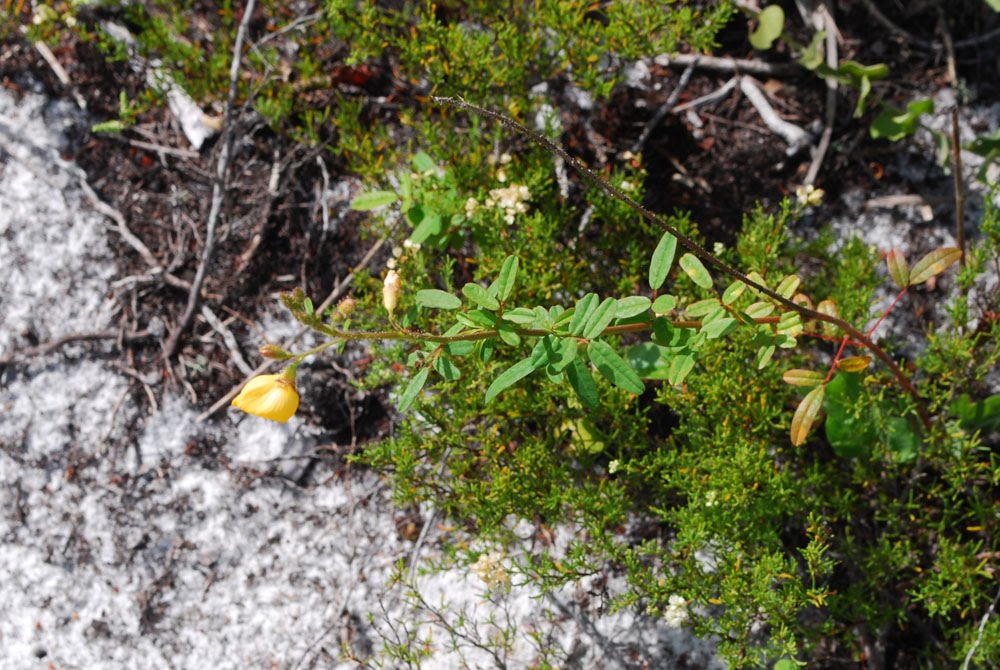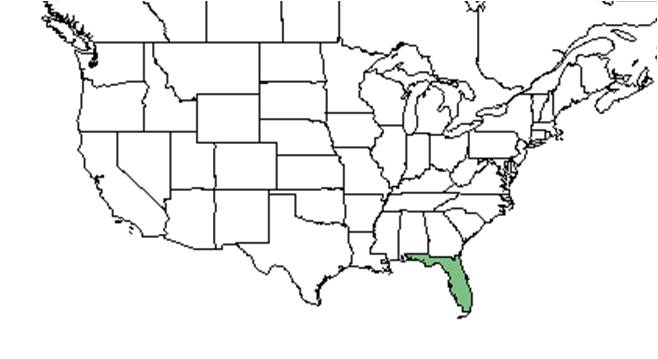Difference between revisions of "Chapmannia floridana"
(→Photo Gallery) |
Krobertson (talk | contribs) |
||
| Line 22: | Line 22: | ||
==Description== | ==Description== | ||
<!-- Basic life history facts such as annual/perrenial, monoecious/dioecious, root morphology, seed type, etc. --> | <!-- Basic life history facts such as annual/perrenial, monoecious/dioecious, root morphology, seed type, etc. --> | ||
| − | ''C. floridana'' is an erect perennial herb arising from a fleshy tap root and can reach three feet in height ( | + | ''C. floridana'' is an erect perennial herb arising from a fleshy tap root and can reach three feet in height<ref>Gunn, Charles R., Eliane M. Norman, and J. Stuart Lassetter. “Chapmannia Floridana Torrey & Gray (fabaceae)”. Brittonia 32.2 (1980): 178–185. </ref>. All parts of the plant are covered with sticky hairs and leaves are alternately arranged <ref name="Native">[[http://hawthornhillwildflowers.blogspot.com/2014/10/alicia-chapmannia-floridana.htm Native Florida Wildflowers]]Accessed: December 4, 2015</ref>. It is a nitrogen fixer<ref name="Mayfield">Mayfield, Margaret M.. “Pollinators of Chapmannia Floridana (fabaceae) and Their Foraging Preferences”. The Florida Entomologist 81.4 (1998): 489–496.</ref>. |
==Distribution== | ==Distribution== | ||
| Line 29: | Line 29: | ||
==Ecology== | ==Ecology== | ||
===Habitat=== <!--Natural communities, human disturbed habitats, topography, hydrology, soils, light, fire regime requirements for removal of competition, etc.--> | ===Habitat=== <!--Natural communities, human disturbed habitats, topography, hydrology, soils, light, fire regime requirements for removal of competition, etc.--> | ||
| − | In the Coastal Plain in Florida, ''C. floridana'' has been found in turkey oak/longleaf pine sand ridges; pine-palmettos flatwoods; longleaf pine-wiregrass ridges; and scrub oak sand ridges. It is found in large populations in highly disturbed areas compared to undisturbed areas, making it unusual from other Florida endemic scrub species which are sensitive to disturbance | + | In the Coastal Plain in Florida, ''C. floridana'' has been found in turkey oak/longleaf pine sand ridges; pine-palmettos flatwoods; longleaf pine-wiregrass ridges; and scrub oak sand ridges. It is found in large populations in highly disturbed areas compared to undisturbed areas, making it unusual from other Florida endemic scrub species which are sensitive to disturbance<ref name="Mayfield"></ref>. Populations have been found in disturbed areas such as heavily cattle grazed longleaf pine-saw palmetto flatwoods, roadsides, and pastures<ref name="Mayfield"></ref><ref name="FSU">Florida State University Robert K. Godfrey Herbarium database. URL: [http://herbarium.bio.fsu.edu http://herbarium.bio.fsu.edu]. Last accessed: October 2015. Collectors: Loran C. Anderson, J. Beckner, D. Burch, J. Carmichael, A. Gholson Jr., R.K. Godfrey, Richard D. Houk, R. Kral, K.M. Meyer, Allen G. Shuey, A. Townesmith, D.B. Ward. States and Counties: Florida: Clay, DeSoto, Glades, Lake, Marion, Orange, Osceola, Polk, Seminole. Compiled by Tall Timbers Research Station and Land Conservancy.</ref>. |
===Phenology=== <!--Timing off flowering, fruiting, seed dispersal, and environmental triggers. Cite PanFlora website if appropriate: http://www.gilnelson.com/PanFlora/ --> | ===Phenology=== <!--Timing off flowering, fruiting, seed dispersal, and environmental triggers. Cite PanFlora website if appropriate: http://www.gilnelson.com/PanFlora/ --> | ||
| − | Flowers are yellow and orange and are composed of three petals <ref name="Native"/>. It flowers May through June and fruits in May | + | Flowers are yellow and orange and are composed of three petals <ref name="Native"/>. It flowers May through June and fruits in May<ref name="FSU"></ref>. |
<!--===Seed dispersal===--> | <!--===Seed dispersal===--> | ||
<!--===Seed bank and germination===--> | <!--===Seed bank and germination===--> | ||
===Fire ecology=== <!--Fire tolerance, fire dependence, adaptive fire responses--> | ===Fire ecology=== <!--Fire tolerance, fire dependence, adaptive fire responses--> | ||
| − | Carrington (1999) found ''C. floridana'' to be a strong re-sprouter after fire, however it did not show a strong flowering response. Seedlings were only present for five months post-fire, suggesting a weak seedling establishment after fire | + | Carrington (1999) found ''C. floridana'' to be a strong re-sprouter after fire, however it did not show a strong flowering response.<ref name="Carrington">Carrington, M. E. (1999). "Post-fire seedling establishment in Florida sand pine scrub." Journal of Vegetation Science 10(3): 403-412.</ref> Seedlings were only present for five months post-fire, suggesting a weak seedling establishment after fire<ref name="Carrington"></ref>. Populations have been observed to be low in undisturbed, burned areas<ref name="Mayfield"></ref>. |
===Pollination=== | ===Pollination=== | ||
| − | ''Bombus impatiens'' and ''Augochloropsis'' are the major visitors to ''C. floridana''. They have been observed ripping holes in the sides of the keel petals of the flower and vibrating their wings to get pollen out of the floral tube. Pollinators visitation rates are affected by temperature, flower size, and flowering density | + | ''Bombus impatiens'' and ''Augochloropsis'' are the major visitors to ''C. floridana''. They have been observed ripping holes in the sides of the keel petals of the flower and vibrating their wings to get pollen out of the floral tube. Pollinators visitation rates are affected by temperature, flower size, and flowering density<ref name="Mayfield"></ref>. |
| − | The following Hymenoptera families and species were observed visiting flowers of ''Chapmannia floridana'' at Archbold Biological Station | + | The following Hymenoptera families and species were observed visiting flowers of ''Chapmannia floridana'' at Archbold Biological Station<ref>Deyrup, M.A. and N.D. 2015. Database of observations of Hymenoptera visitations to flowers of plants on Archbold Biological Station, Florida, USA.</ref>: |
Apidae: ''Bombus impatiens'' | Apidae: ''Bombus impatiens'' | ||
| Line 51: | Line 51: | ||
Global status rank: G5 secure <ref name="EOL">[[http://eol.org/pages/642067/details Encyclopedia of Life]] Accessed December 4, 2015</ref>. | Global status rank: G5 secure <ref name="EOL">[[http://eol.org/pages/642067/details Encyclopedia of Life]] Accessed December 4, 2015</ref>. | ||
<!--==Cultivation and restoration==--> | <!--==Cultivation and restoration==--> | ||
| − | ==Photo Gallery== | + | <!--==Photo Gallery==--> |
<gallery widths=180px> | <gallery widths=180px> | ||
</gallery> | </gallery> | ||
==References and notes== | ==References and notes== | ||
| − | |||
| − | |||
| − | |||
| − | |||
| − | |||
| − | |||
| − | |||
| − | |||
| − | |||
Revision as of 19:05, 18 May 2016
| Chapmannia floridana | |
|---|---|

| |
| Photo by Wayne Matchett, SpaceCoastWildflowers.com | |
| Scientific classification | |
| Kingdom: | Plantae |
| Division: | Magnoliophyta - Flowering plants |
| Class: | Magnoliopsida - Dicotyledons |
| Order: | Fabales |
| Family: | Fabaceae ⁄ Leguminosae |
| Genus: | Chapmannia |
| Species: | C. floridana |
| Binomial name | |
| Chapmannia floridana Torr. & A. Gray | |

| |
| Natural range of Chapmannia floridana from USDA NRCS Plants Database. | |
Common name: Florida alicia
Contents
Description
C. floridana is an erect perennial herb arising from a fleshy tap root and can reach three feet in height[1]. All parts of the plant are covered with sticky hairs and leaves are alternately arranged [2]. It is a nitrogen fixer[3].
Distribution
It is endemic to Florida [2].
Ecology
Habitat
In the Coastal Plain in Florida, C. floridana has been found in turkey oak/longleaf pine sand ridges; pine-palmettos flatwoods; longleaf pine-wiregrass ridges; and scrub oak sand ridges. It is found in large populations in highly disturbed areas compared to undisturbed areas, making it unusual from other Florida endemic scrub species which are sensitive to disturbance[3]. Populations have been found in disturbed areas such as heavily cattle grazed longleaf pine-saw palmetto flatwoods, roadsides, and pastures[3][4].
Phenology
Flowers are yellow and orange and are composed of three petals [2]. It flowers May through June and fruits in May[4].
Fire ecology
Carrington (1999) found C. floridana to be a strong re-sprouter after fire, however it did not show a strong flowering response.[5] Seedlings were only present for five months post-fire, suggesting a weak seedling establishment after fire[5]. Populations have been observed to be low in undisturbed, burned areas[3].
Pollination
Bombus impatiens and Augochloropsis are the major visitors to C. floridana. They have been observed ripping holes in the sides of the keel petals of the flower and vibrating their wings to get pollen out of the floral tube. Pollinators visitation rates are affected by temperature, flower size, and flowering density[3].
The following Hymenoptera families and species were observed visiting flowers of Chapmannia floridana at Archbold Biological Station[6]:
Apidae: Bombus impatiens
Halictidae: Augochlorella aurata, Augochloropsis metallica, Lasioglossum nymphalis, L. placidensis
Conservation and Management
Global status rank: G5 secure [7].
References and notes
- ↑ Gunn, Charles R., Eliane M. Norman, and J. Stuart Lassetter. “Chapmannia Floridana Torrey & Gray (fabaceae)”. Brittonia 32.2 (1980): 178–185.
- ↑ 2.0 2.1 2.2 [Native Florida Wildflowers]Accessed: December 4, 2015
- ↑ 3.0 3.1 3.2 3.3 3.4 Mayfield, Margaret M.. “Pollinators of Chapmannia Floridana (fabaceae) and Their Foraging Preferences”. The Florida Entomologist 81.4 (1998): 489–496.
- ↑ 4.0 4.1 Florida State University Robert K. Godfrey Herbarium database. URL: http://herbarium.bio.fsu.edu. Last accessed: October 2015. Collectors: Loran C. Anderson, J. Beckner, D. Burch, J. Carmichael, A. Gholson Jr., R.K. Godfrey, Richard D. Houk, R. Kral, K.M. Meyer, Allen G. Shuey, A. Townesmith, D.B. Ward. States and Counties: Florida: Clay, DeSoto, Glades, Lake, Marion, Orange, Osceola, Polk, Seminole. Compiled by Tall Timbers Research Station and Land Conservancy.
- ↑ 5.0 5.1 Carrington, M. E. (1999). "Post-fire seedling establishment in Florida sand pine scrub." Journal of Vegetation Science 10(3): 403-412.
- ↑ Deyrup, M.A. and N.D. 2015. Database of observations of Hymenoptera visitations to flowers of plants on Archbold Biological Station, Florida, USA.
- ↑ [Encyclopedia of Life] Accessed December 4, 2015